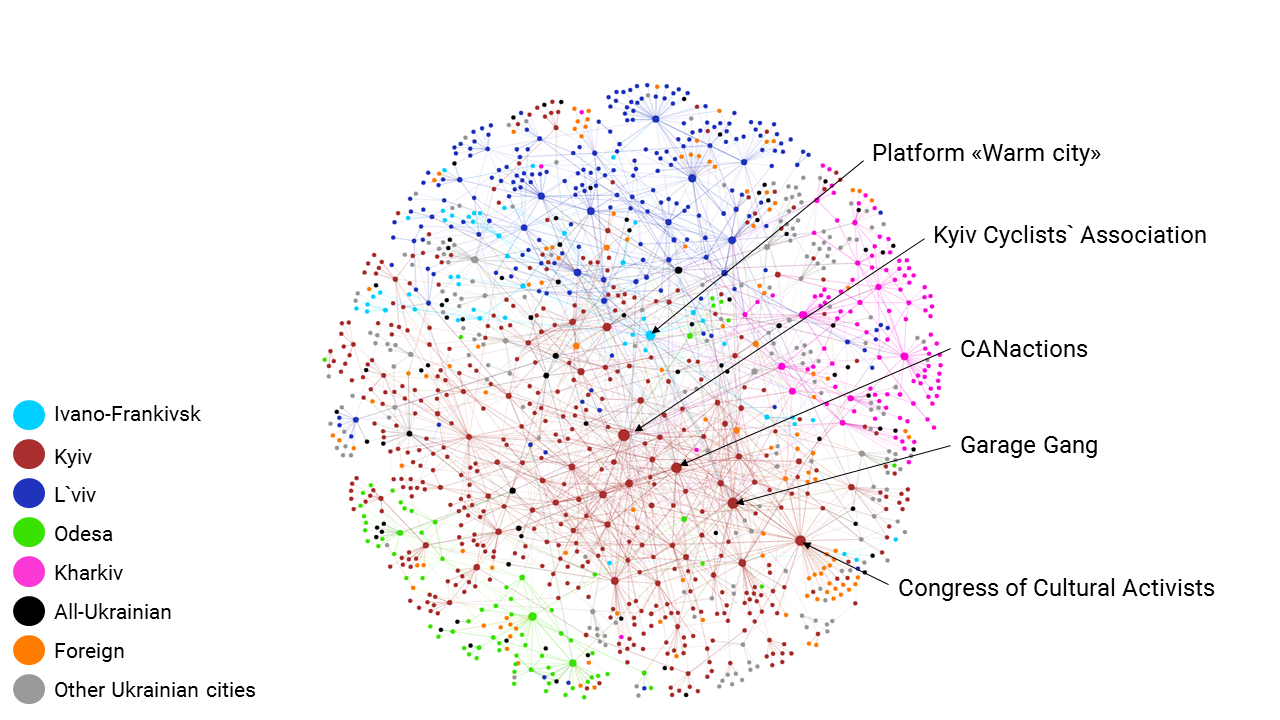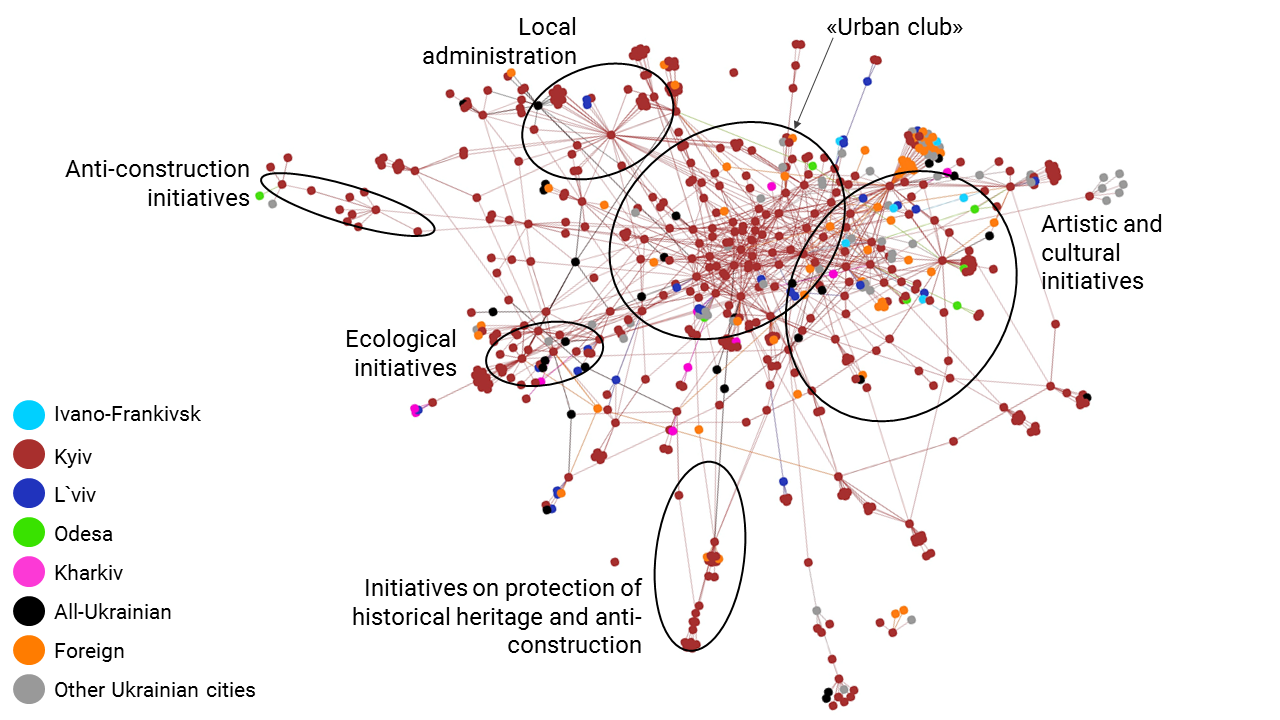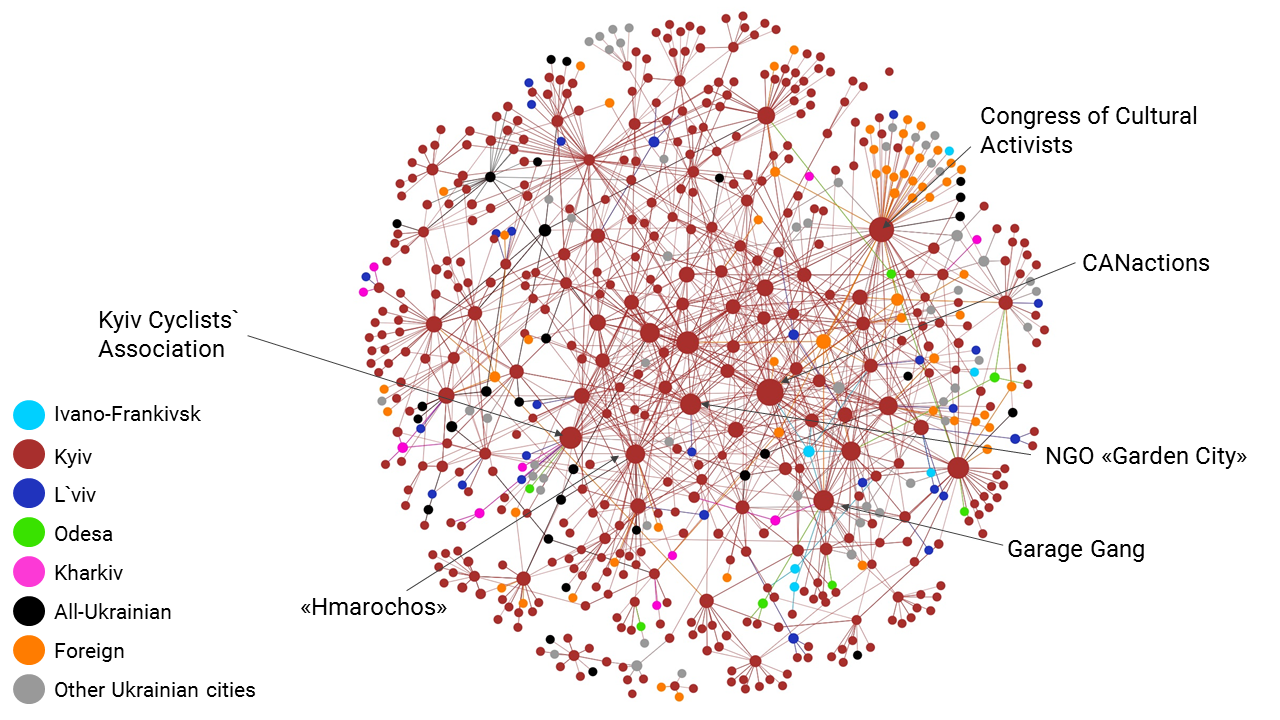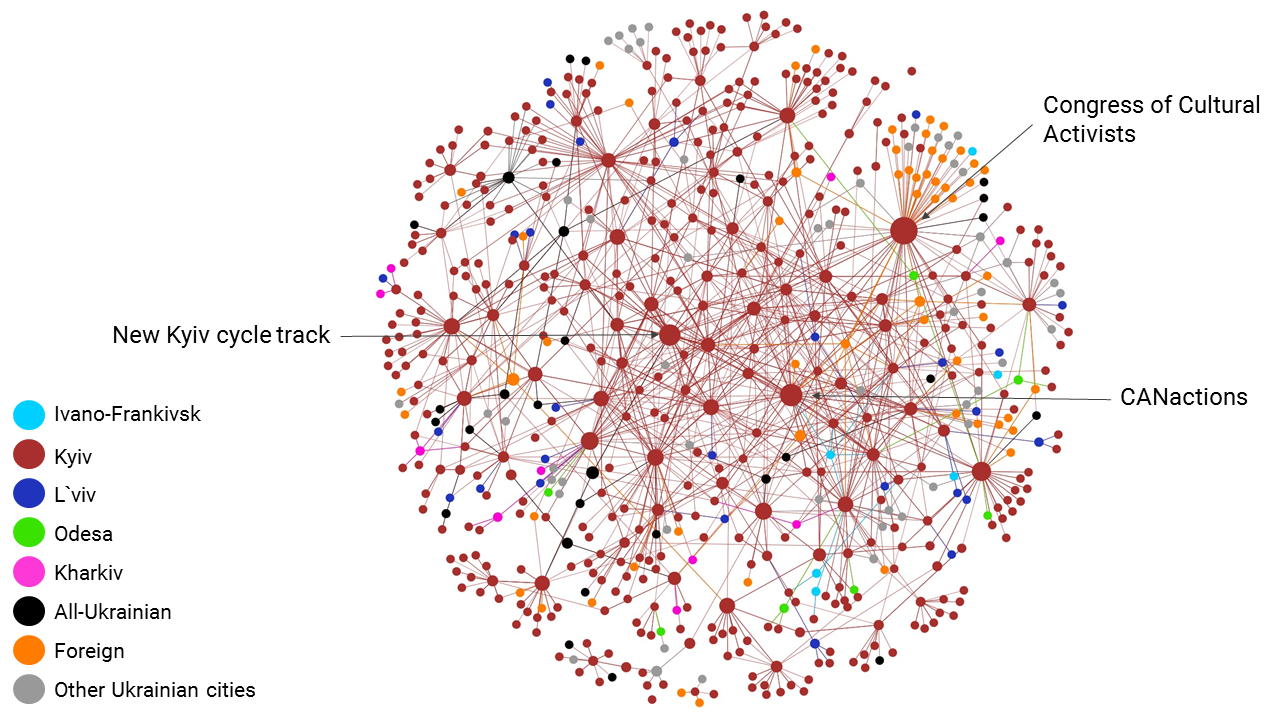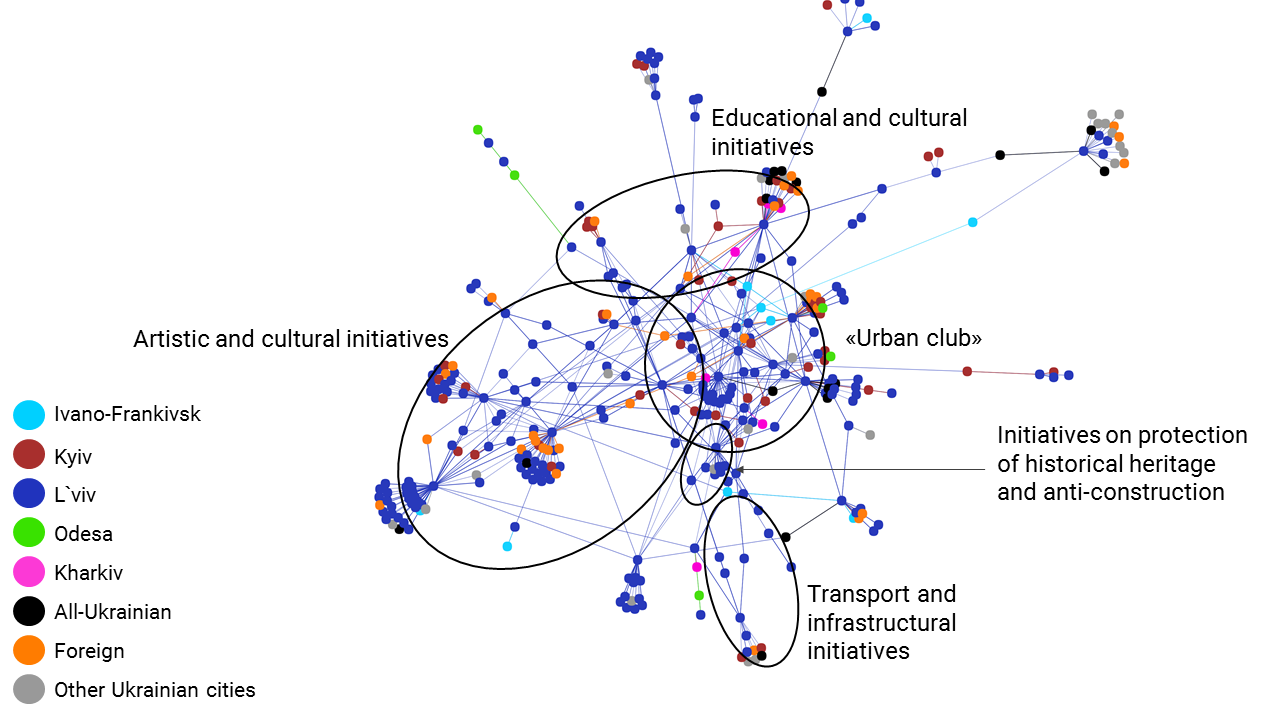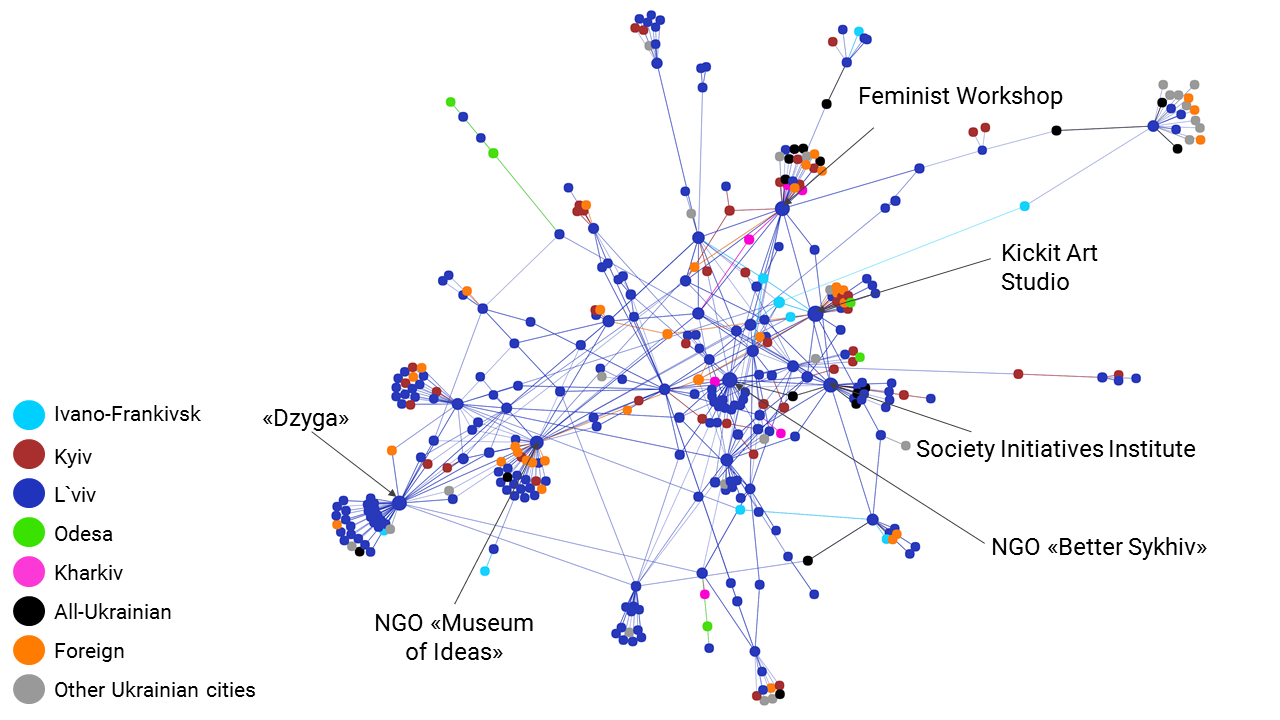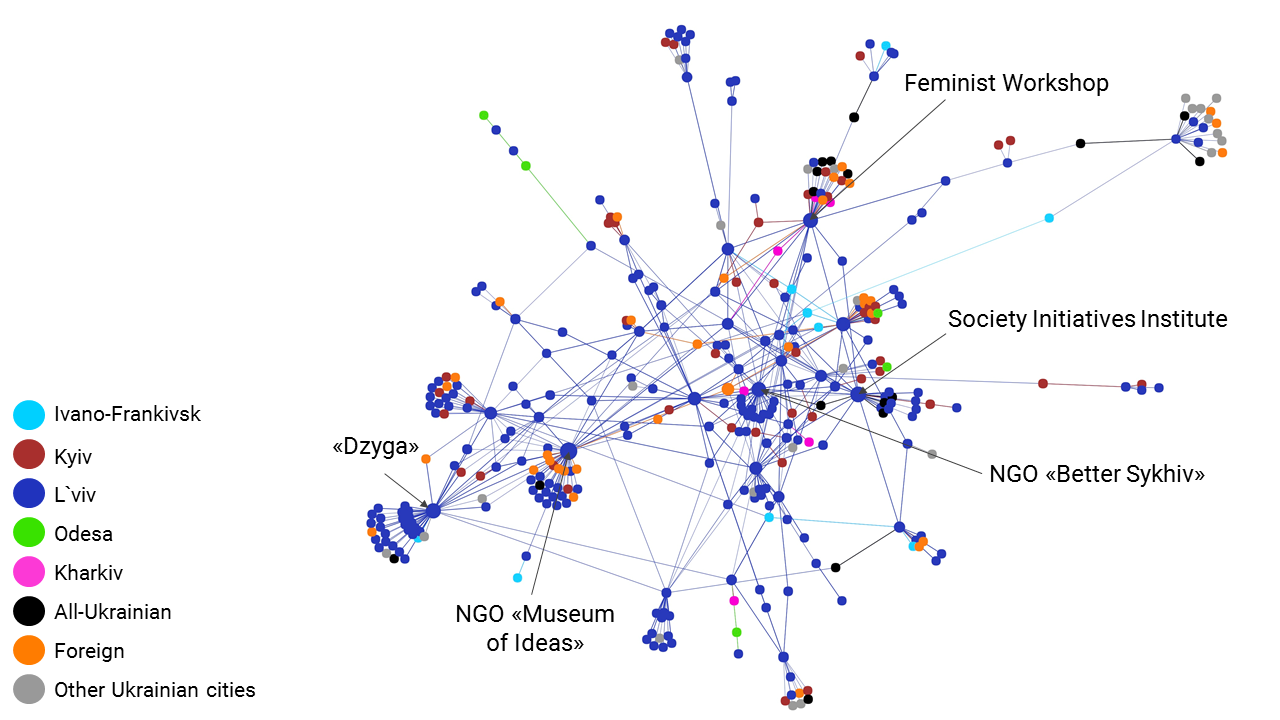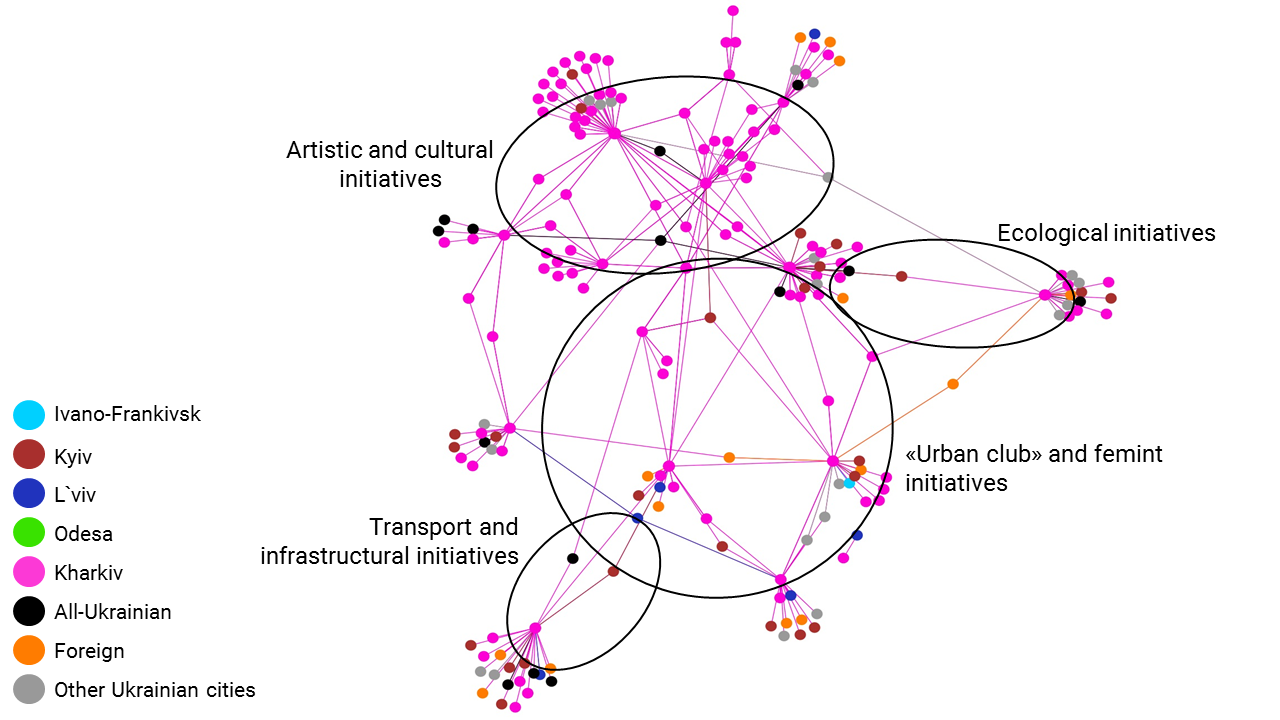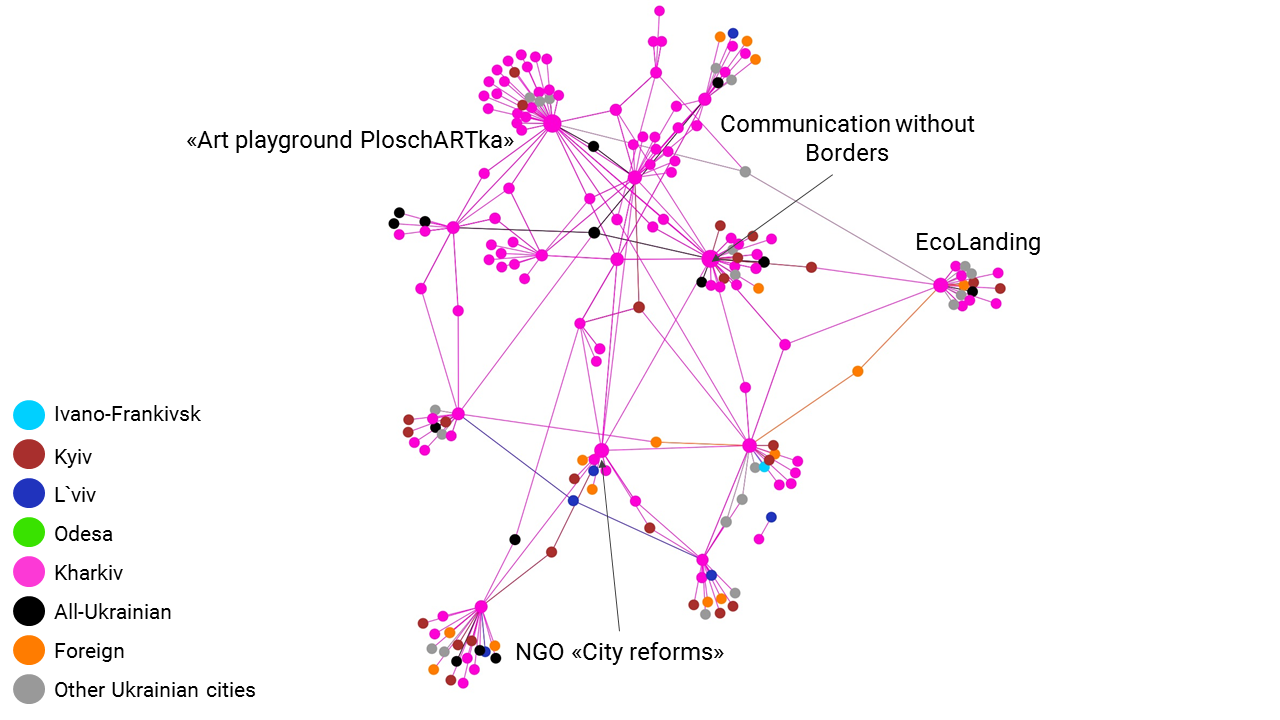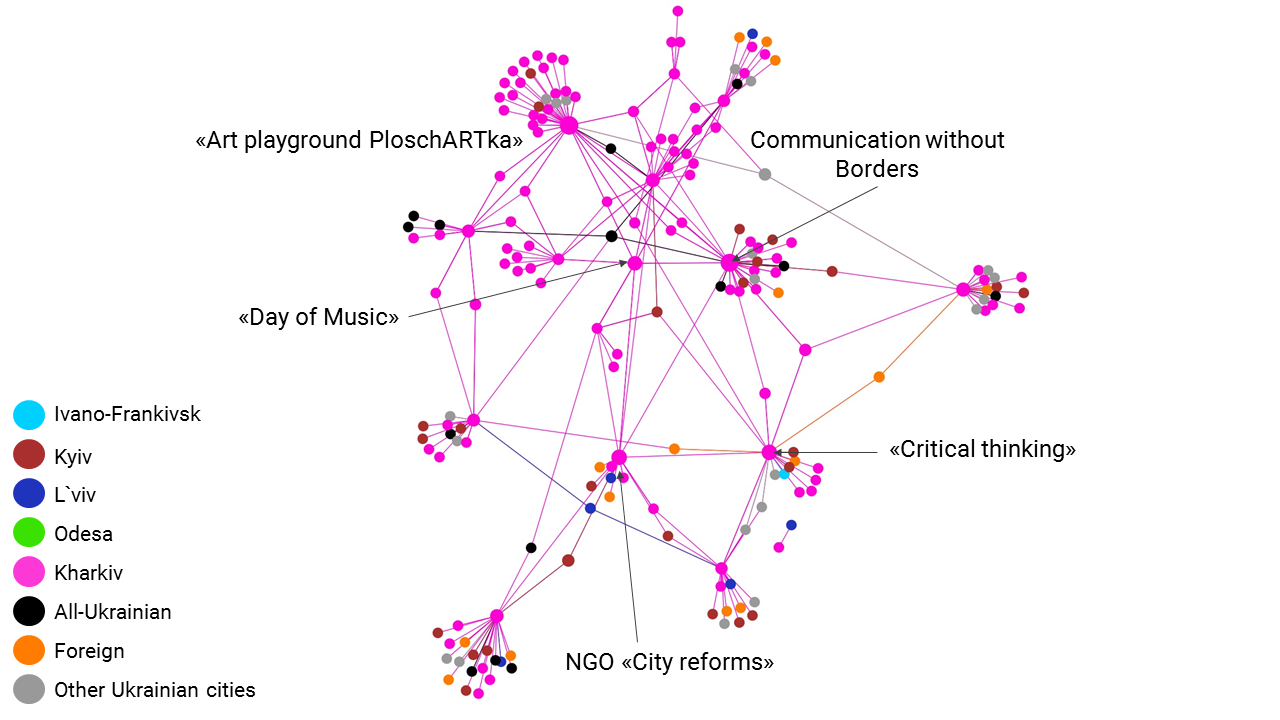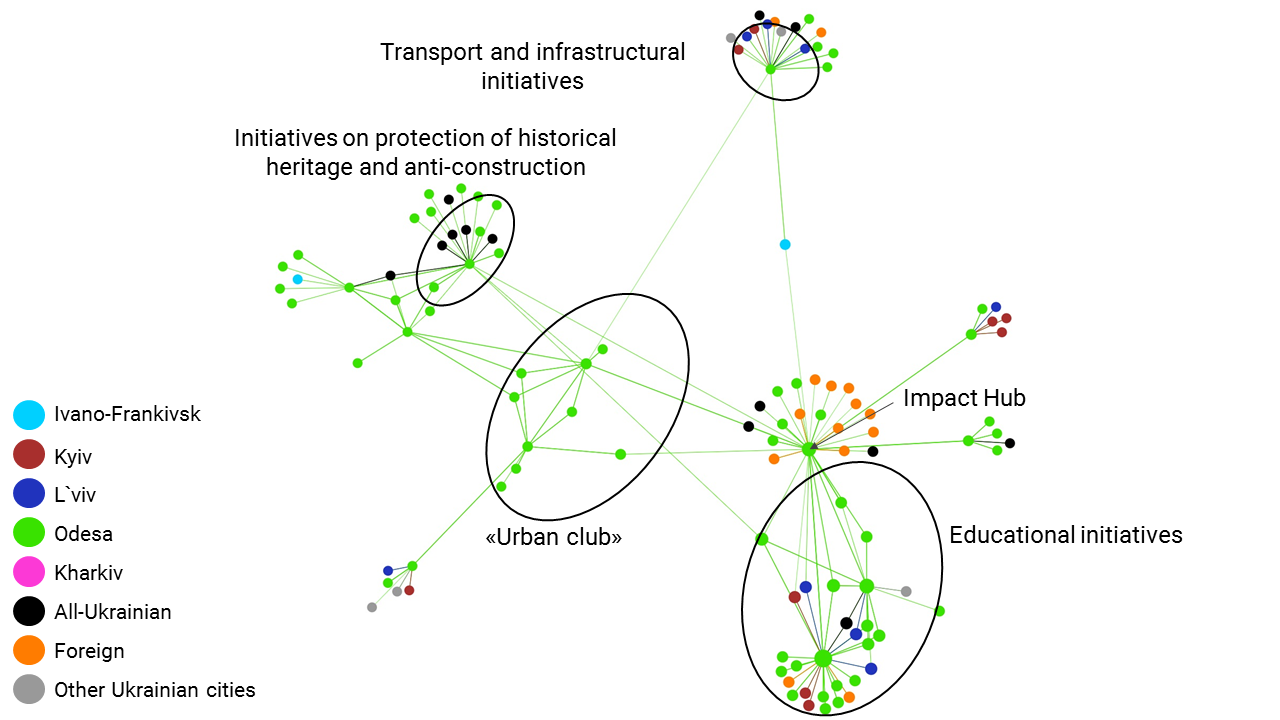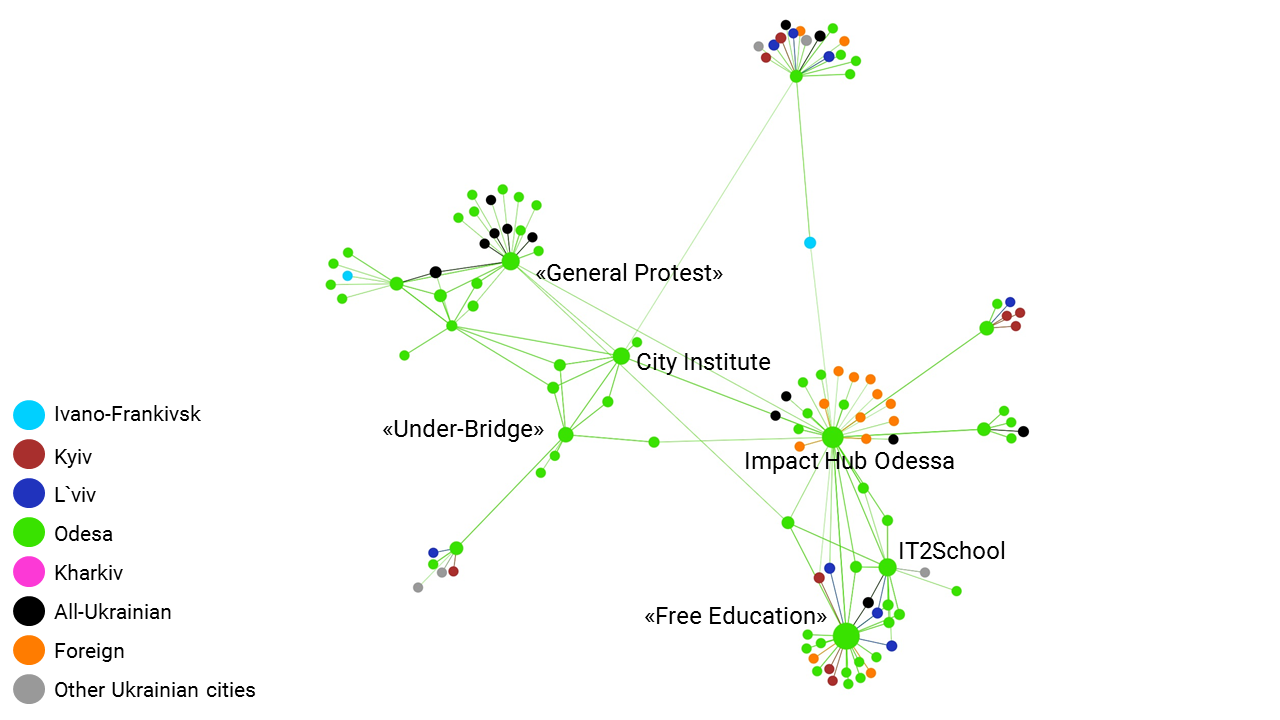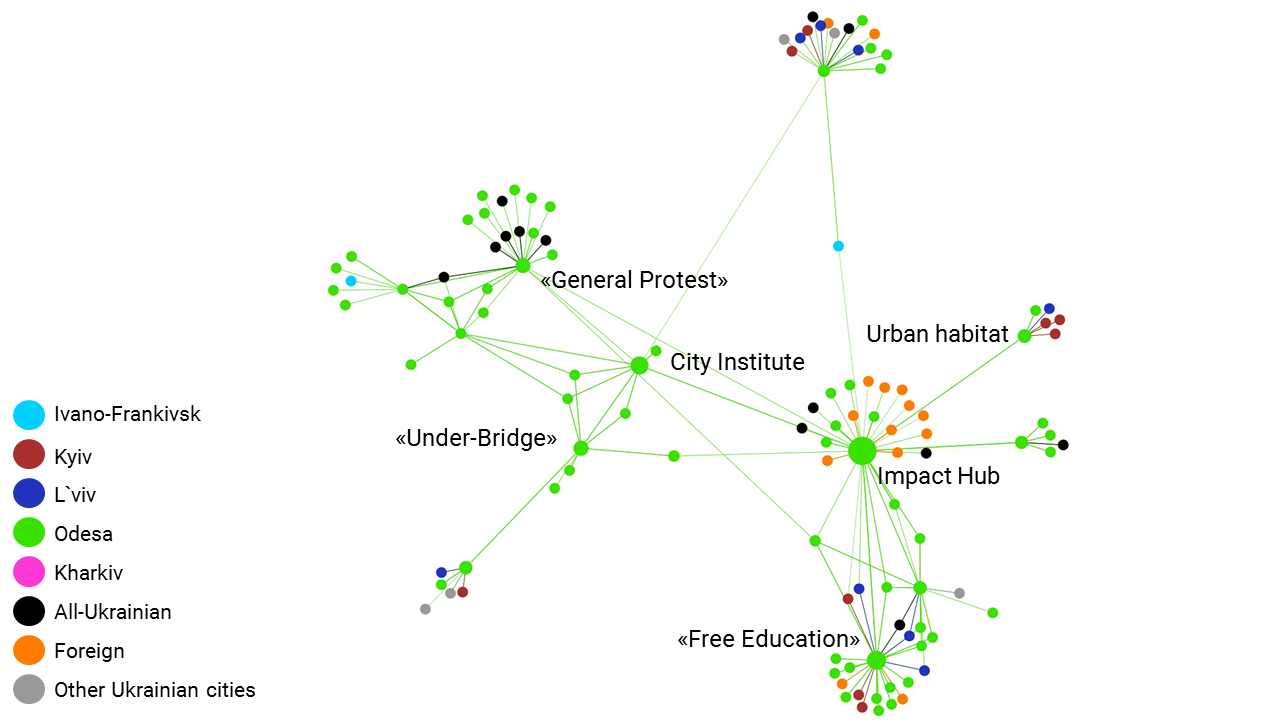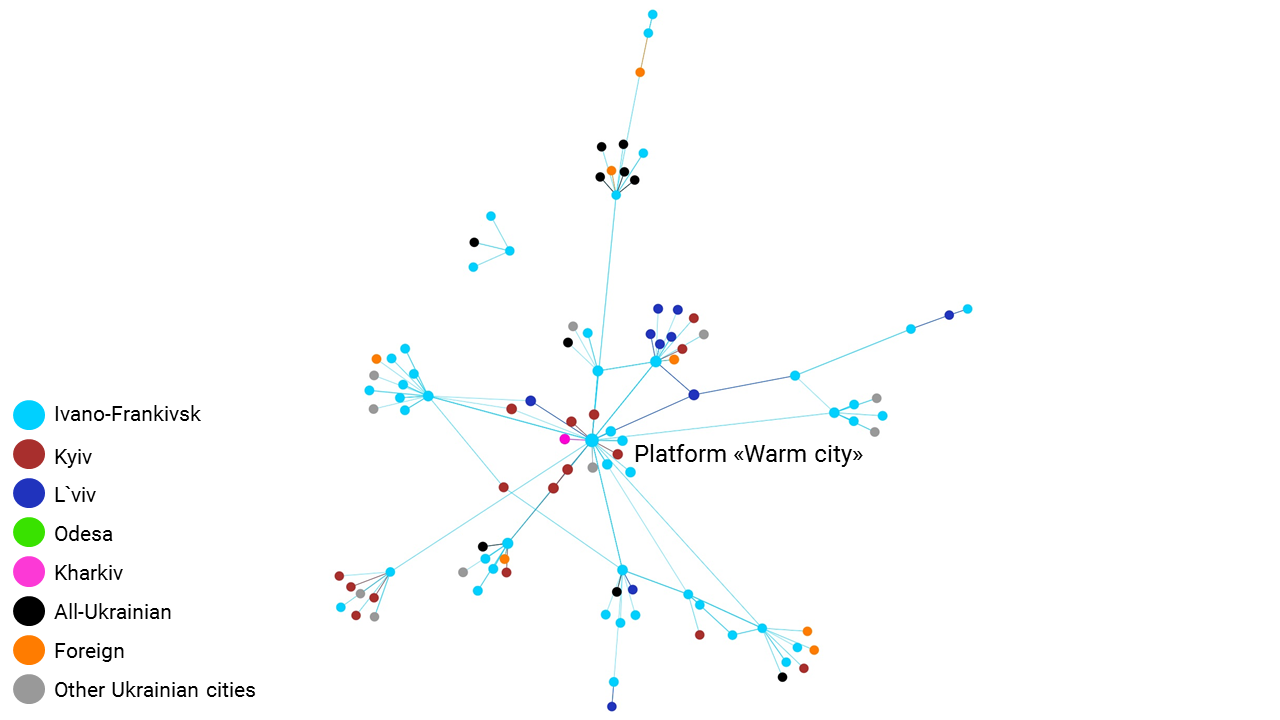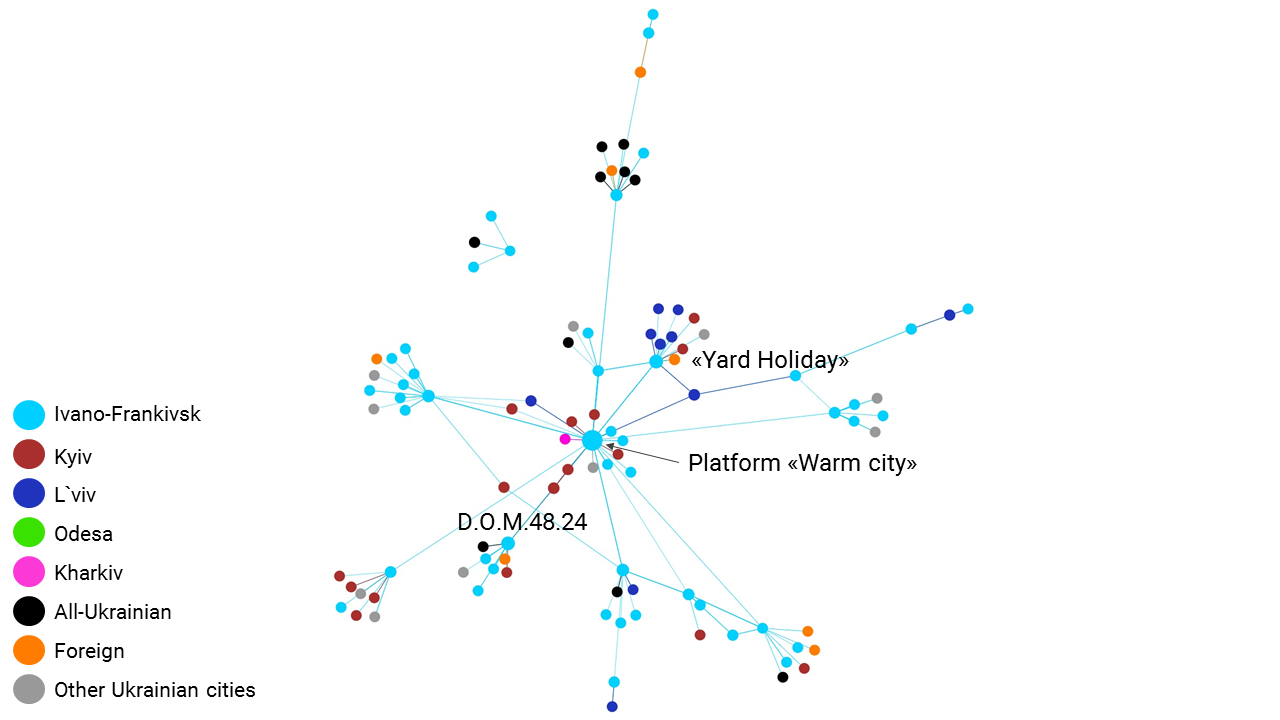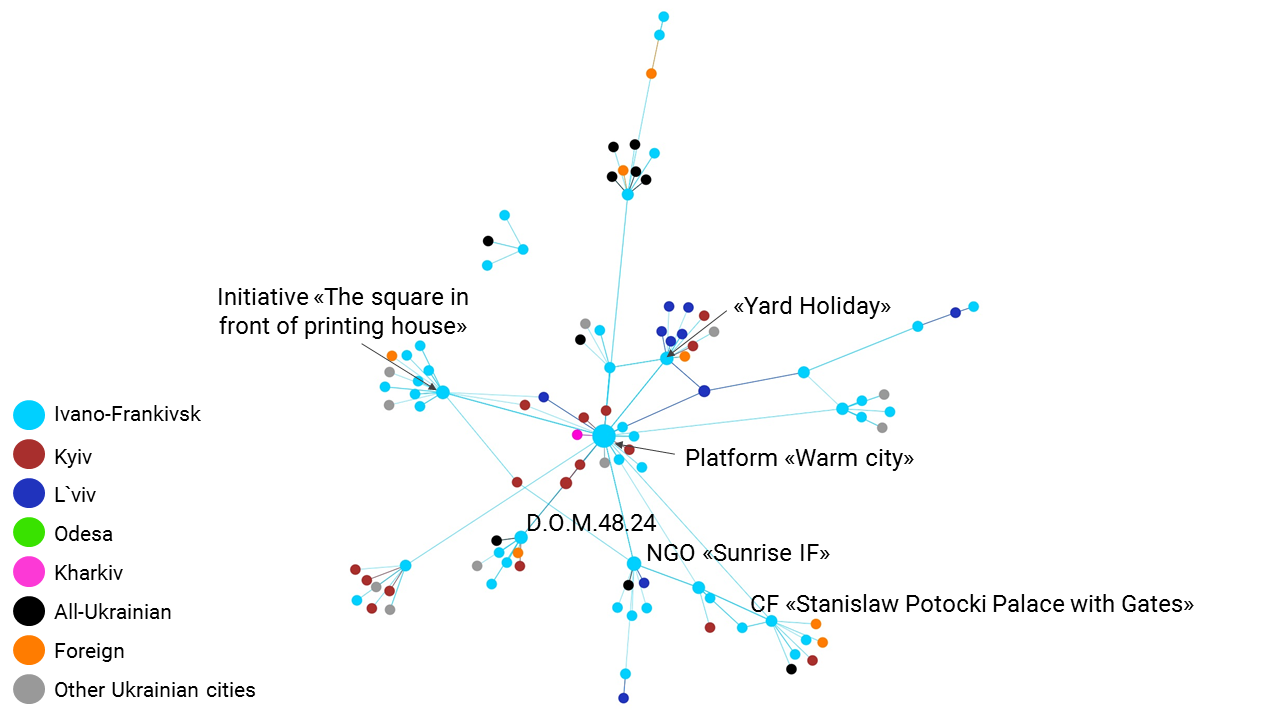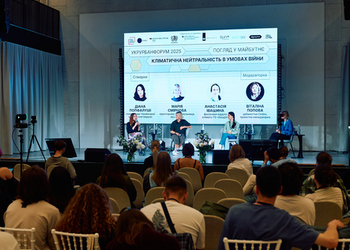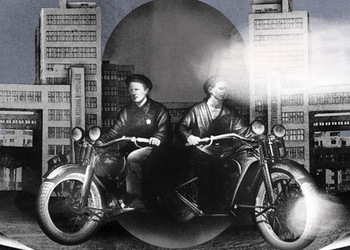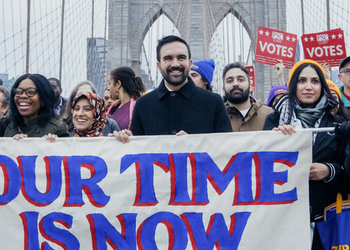Grass-roots initiatives are one of the key actors of civic engagement into the urban development decision-making process. Grass-roots social movements and initiatives have recently become increasingly popular in big Ukrainian cities. «Euromaidan» protest movements have become an important step for emergence and development of such organizations. A special focus of attention in the urban grassroots initiatives study is the research of their networks — connections with the organizations in their city, as well as with their «neighbors» from other cities. Firstly, networking involves sharing of information and resources, which, respectively, can improve the efficiency of initiatives activities and help to share experience with other initiatives. Secondly, an effective network of cooperation allows to create the basis for civil society. The article concerns the results of the research, conducted by CEDOS think-tank (Kyiv, Ukraine) in February — July 2016 within 5 Ukrainian cities — Kyiv, Kharkiv, L’viv, Ivano-Frankivsk and Odesa. The network of urban grass-roots initiatives and organizations contains of 175 ego-networks. The network contains of 1365 actors. The article presents the main results of the research and shows the shared tendencies for urban grass-roots in Ukrainian cities and also the differences between the networks of cities.
Read also:
Charter of Ukrainian Urban Movement
After the protests in winter 2013-2014 the number of active civil movements of different branches has increased. There were (specific for the following events) volunteering organizations which work with IDP’s and army, organizations working on political and economic reforms and cultural initiatives were set up. Local urban communities and urban issues were also taken into consideration — a number of organizations and initiatives working with specifically urban issues were created.
It is important that the part of such formations are grassroots initiatives — movements, which evolve after the community (e.g. local dwellers) decide they want to solve their local problems without local authorities’ special initiation of this process. According to V. Sereda (2010), civil society organizations in post-soviet countries are communicative mediators between locals and the authorities of different levels. Thereafter, as for the urban context, organizations and initiatives working on urban issues become intermediates between city dwellers and local authorities. This, in turn, allows city dwellers to defend their interests and to inform authorities on their wills and demand in a more efficient way.
Grassroots initiatives can be also considered as one of the most important actors of involving the city dwellers into the various activities. Thus, the communities, which are mainly shaped of groups of people who share same ideas, or shaped according to the location (e.g. neighbourhood communities) are able to involve people to their own activities. This, in turn, allows to solve city problems and to educate dwellers on how can they defend their own interests simultaneously. Thereby, development of grassroots movements and initiatives together with the development of other civil society organizations initiates the development of civil society itself and empowers city dwellers and their communities.
Regarding to this, civil activism as a social practice raise a set of questions for researchers and for activists — what people take part in such activities, what is the number of Ukrainian initiatives and which spheres do they work in, what is the way of their development. These questions were risen in the works of V. Sereda (who researched the development of civil activism in Ukraine after Euromaidan), «City Institute» (who studied motivation of urban activists to participate in such activities) from L’viv. There are also some studies on the development of civil society from the sociological department of Ilko Kucheriv Democrtaic Initiatives Foundation. However, topics of urban activism and urban grassroots initiatives have not yet been taken as a separate object of study. There is a number of research projects towards city dwellers’ participation in urban management; the databases of initiatives are created; separate publications are dedicated to the best practices of participation.
Nonetheless, to study the phenomenon of grassroots initiatives and their development it is important to (1) understand the way they were set up, (2) understand in which scope of urban issues they tend to work and to (3) find out how these initiatives and organizations interact, in order to understand the way the civil sphere develops in Ukrainian cities. In terms of the movement’s development not only the growth of number, but also their qualitative development is important. Existence of the interaction network can, in it’s turn, create the specific community of initiatives and organizations. It can also bring them such benefits as: access to the resources, emotional intergroup support (Krackhardt 1993), possibility of quick mobilization of people and resources and sharing their agenda (Valente 1995). Thus, it was important to find out if initiatives and organizations in Ukrainian cities get and share such benefits, as these benefits can influence the pace and the effectiveness of the movement’s development. This article is aimed to draw out the results of the research, which was conducted by CEDOS think-tank on February-July 2016.
There was no such research made in Ukraine before. That is why we needed to make a database of grassroots initiatives and organizations, which work in the scope of urban issues; to study their ties and their network. A single important point was to reveal the network structure. We tried to study if success gained through the strength of weak ties (Granovetter 1973) prevail in the network, or if the success gained through brokerage and filling the structural holes (Burt 2008) does. If under the first condition actors, whose position provides them with the high number of weak ties, are influential, then under the second one effectiveness and successfulness raise in situation of linking of several separated subgroups. It was important for us to study this both on the city and the intercity levels.
Research methodology
The study of the network of urban grassroots initiatives and organizations in Kyiv, Kharkiv, L’viv, Odesa and Ivano-Frankivsk was conducted by CEDOS between February and July 2016 supported by Charles Stewart Mott Foundation. The main objective of the study was to reveal the structure of ties between urban initiatives in five Ukrainian cities — Kyiv, Kharkiv, L’viv, Ivano-Frankivsk and Odesa. The main tasks were as follows:
- To define the network size for initiatives in each target city;
- To reveal the structural particularities of the networks of interaction between urban initiatives and organizations;
- To identify main central actors and brokers in the network;
- To describe the structure of actors’ interaction in the networks by three types of relations — running joint projects, attending events of other organizations, and information exchange;
- To develop recommendations for network actors — urban grassroots initiatives and organizations — basing on the survey results.
Online-survey was applied for data collection. The questionnaire was disseminated via e-mail and social media (Facebook, VKontakte) using private messaging to initiatives leaders. Leaders or other representatives of the initiative/organization who were competent enough to report about the interaction of their initiative/organizations with the other organizations served as respondents.
Method of continuous sampling was applied. The data was collected during 4 survey waves. The questionnaire was disseminated among organizations and initiatives working in 5 cities and listed by the survey group using the online search of these organizations. Additional recruitment of respondents was performed as «snowball method» during next stages of the survey — the questionnaire was sent to those initiatives and organizations mentioned by respondents in the first wave.
The questionnaire was sent to 425 initiatives during 4 waves, and 175 of these initiatives participated in the survey (response rate reached 41%). 76 organizations (43%) among the surveyed ones are Kyiv-based, 32 organizations (18%) are from L’viv, 15 organizations (9%) — from Kharkiv, 14 organizations (8%) — from Odesa, 13 (7%) are from Ivano-Frankivsk, and 19 (11%) from other cities of Ukraine, 6 (3%) organizations operate in several cities or nationwide.
The survey tool used relation-based method — respondents were given six questions, each of which were related to their interaction with other initiatives and organizations. In each question the respondents could indicate 10 and more initiatives and organizations they are linked to in any way. Survey questions correspond with the types of ties defined for the analysis. Three types of ties were analysed in the survey — strong ties (questions about (1) presence of parent/subsidiary initiatives and organizations and arrangement of joint projects with other initiatives and organizations, and weak ties (questions about (1) attending events of other initiatives or organizations and (2) information interaction). The questionnaire also included the issues regarding the year when organization was established, main working focus, and localization / coverage of activities.
The character of initiatives interaction and particularities of the network formed with this interaction is in the survey focus. Therefore, the following network characteristics were analysed: degree centrality, betweenness, and eigenvector centrality. In addition to the definition of influential actors in the network these characteristics allow for explaining the structures like structural holes and start-like subnetwork in the network. The following structural characteristics of the network were included into the analysis — cohesion measures (density, compactness), average number of direct ties per actor, number of triads. Data analysis and visualization was performed in UCINET and Polinode.
Overview of the inter-city network of urban grass roots
The survey covered inter-city network of 5 cities as survey participants in terms of interaction between initiatives and organization that deal with urban problems; its structural specifics and centrality and influence of its actors within the city were explored.
It was revealed that ego-networks of actors (organizations) form a joint network of interaction — these ego-networks are connected into one complete network through brokers. This network consists of 175 ego-networks and 1357 actors from various cities, who work in different areas of urban development. The network contains 3436 ties of different types. It is connected, so there are no isolates in it. Therefore, it is rather extended and has a potential for efficient resources transfer, for interaction and cohesion. Hence, the network is strong and productive — complete connectedness allows any actor in this network reaching the other actor. Such respective increases are potential for actors’ interaction.
The network consists of 477 organizations from Kyiv, 230 from L’viv, 111 from Kharkiv, 78 from Odesa, 49 from Ivano-Frankivsk, and 202 from other cities of Ukraine, along with 86 all-Ukrainian organizations, and 124 foreign organizations (Table 1).
| Tab. 1. Distribution of network actors by cities | ||
| City | Count | % |
| Kyiv | 477 | 35% |
| L’viv | 230 | 17% |
| Kharkiv | 111 | 8% |
| Odesa | 78 | 6% |
| Ivano-Frankivsk | 49 | 4% |
| Other cities of Ukraine | 202 | 15% |
| All-Ukrainian | 86 | 6% |
| Other countries | 124 | 9% |
| Total | 1357 | 100% |
The network contains not only urban initiatives and organizations, but also state institutions, international foundations, education and media organizations, etc.
There are 1008 actors in the network that represent civil society. Organizations focused on educational activities within the city, urban development and governance, and self-governance (including organizations running alternative or informal education, education projects, online platforms, i.e. «Prometheus», CANactions, School of citizen activism, etc.) are the most numerous in the network (149 organizations). The second largest by number are the arts and culture initiatives and organizations, cultural industries, art-clusters, organizations dealing with tourism, etс. (i.e. NGO «Congress of culture activists», NGO «Help and Travel», NGO «Texture Art union», platform of cultural initiatives «Isolation», etc.). The third-largest group (131 organizations) consists of festivals, conferences, seminars, workshops, hackathons — regular or one-time events and projects of varied focus directed on participation and interaction of the large number of attendees (i.e. «Right to the city», «Street music Day», «Kharkiv Urban Fest», etc.). The other organizations which remain less numerous but represented in the network are those dealing with environment, energy efficiency, nature and animal protection (82 organizations) (i.e., NGO «Forza», «Green Front», «Let’s Do it», NGO «L’viv Community of Animal Protection», etc). Organizations working in the sphere of urban governance, local self-governance, civic participant and community building are also represented in the network well enough (80 organizations) (for instance, «Podolianochka», All-Ukrainian NGO «Association for community self-organization assistance», Civic Network OPORA, etc.). Organizations working in information dissemination are also present in the network (80 organizations) (i.e., «Mistosite», «ufra.com.ua», «DreamKyiv», etc.) (Tab.2).

996 organizations among all surveyed provided their year of being established. The oldest ones in the network are NSOU Plast and the Ukrainian Youth Association. However, most organizations were founded between 2014 and 2016. Such large number of «young» organizations in the network might be explained with the survey method specifics. On the other hand, flourishing civic activism had been observed in Ukraine since 2014, so considerable number of initiatives was established during the recent two years (Tab. 3).
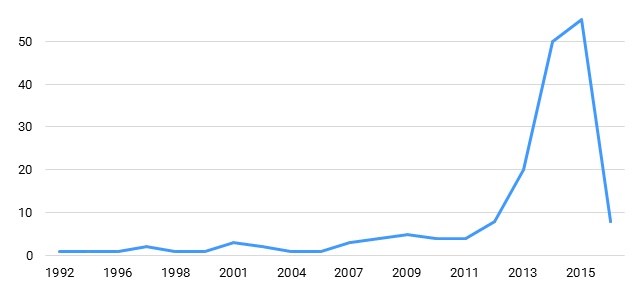
Business representatives constitute a considerable share in the urban initiatives network (100 organizations) as well as state national (13 organizations and institutions) and local authorities (54 organizations and institutions). Business institutions are mostly represented by creative and education spaces, hubs, publishing houses, architectural and urban-planning offices, cafés, campings, tourist agencies, etc. Local institutions in the network include city councils, departments, rayon administrations, communal municipal enterprises and urban projects and initiatives (i.e., «participatory budget of Poltava town», of «Urban workshop»).
Foreign organizations, foundations, institutions are represented rather well in the network. The network includes 88 international and foreign organizations and institutions (i.e. GIZ, European Cyclists Association, Friedrich Naumann Foundation for Freedom, etc), and 21 international foreign festivals, conferences and projects (i.e., Eastern Europe Initiatives Congress 2014). International and foreign organizations include international foundations, civic organizations, foreign information resources and enterprises.
| Tab. 4. Overall network cohesion measures | |
| Density | 0,002 |
| Average N of direct contacts per actor | 4,293 |
| Diameter | 11 |
| Breadth | 0,876 |
| Compactness | 0,124 |
The analysis of network characteristics show that despite connectedness the network is not dense. In contrary, the density shows its dispersion (Tab. 4). What is the reason for that? To answer this question, it is necessary consider factors related to the network structure, as well as characteristics of centrality and power of network actors.
The network structure has some specific representation of different types of ties among the actors. As mentioned above, strong ties indicate mutual connection between the actors, and weak ties indicate unidirectional ties. Thus, different substructures of ties create the directions of resources flows (information, experience, etc.) within the network. The more diverse are the ties and their directions — the more connected is the network in terms of resource exchange. There are start-like subnetworks in the network — where the actors are directly connected to only 1 actor in the centre of the subnetwork. In addition to these subnetworks that are connected with each other through central actors sometimes (and in few cases — through 1-2 subordinate actors), the network also contains chain-like subnetworks. They can lead to decrease in productivity of resource exchange in the whole network. The third important type of ties structure in this network is triads (triangles). Number of complete triads (that can be described as A<->B<->C, A<->C) is only 214 out of 3436 ties in the network. As for other types of triads (i.e. A->B<-C, A<->C and others) is 261. There are 475 triads in the network overall, and it constitutes only the seventh of all ties. Therefore, small number of triads in the network is among the reasons that lead to low cohesion in the network.
Another particular structural feature of the network is that it has a group (subnetwork) of influential (by centrality measures) initiatives and organizations with the highest density within its group. And the density between their group and the outer network community is lower. These actors deal with various aspects of urban development, from local government to revitalization (unlike other subgroups that are formed mostly around one issue). This group also contains network brokers and the most central initiatives. Due to the absence of one common focus and forming a group due to joint influence this group was named «urban club». Initiatives and organizations interact actively within this «club», but they have much less ties with the part of the network outside their group. It also has a large number of triads, so most of actors are connected with each other.
Initiatives that are not in the «club» remain peripheral in the network and lose opportunity to become influential. So, the most efficient strategy for less influential initiatives to ensure advantageous network position is to get connected (preferably with strong ties) with the actors in the «club», On the other hand, the strategy of creating own «clubs» — joint consolidated groups might also assist in becoming more influential in the network. However, each of these two strategies has both positive and negative outcomes. The advantages of the first approach are creating the ties with influential actors, access to resources being distributed within the «club»; the advantage of the second approach is forming of own consolidated group that will get stronger due to various ties between its participants. However, closing of «clubs» [towards each other] can have negative effect and more structural holes will appear in the network — the network will get less connected, brokers who connect different parts of the network will possess more advantageous position.
What initiatives and organizations are influential due to their centrality? The distribution of actors by these measures is displayed below (picture 1).
As we can see, initiatives are mostly grouped by city, and only few actors serve as inter-city brokers. This situation can be a reason for low cohesion — the network has several groups connected by few actors.
Organizations with large number of projects in various cities or those disseminating their ideas beyond their home city serve as man brokers in the network. These brokers are educational organizations and organizations dealing with transport and mobility issues. It might be explained with the situation when such organizations focus on issues that requires involvement of other actors from other cities (i.e. as with the issue of mobility) or when they have experience and knowledge that they aim to disseminate — and that is their main activity (education organizations). Thus, organizations that need wider circle of other organizations in other cities or inside their home cities operate in a way when they set numerous ties with the other actors in their city and beyond. Considering grouping by city, such organizations become brokers that are the only bridging organizations for disconnected groups.
Moreover, in some cases international organizations and foundations serve as brokers. That might be explained with the grant (or other) support they provide to the organizations in other cities, with the events they organize (forums, conferences) for sharing experience, creating a space for interaction.
In addition to small number of inter-city brokers, another factor of low cohesion is that home city serves as the primary factor of crating subgroups in the network. Thus, in-city networks become closed within the city boundaries, not having access to resources (information, contacts, experience etc. in other cities. Similar trend is observed for grouping inside the cities — by the thematic focus of activities. So, actors form separate groups in the inter-city network and inside the city, and these groups are connected with a few brokers. This situation leads to the constraints in the number of resource distribution channels and to disperse structure of the network.
It is important that in addition to initiatives and organizations representing the «third sector» the network has also local government representatives (and subordinate institutions), and business structures. Actors that have to interact with local authorities get higher centrality scores and higher influence in the network. It is important that some institutions (i.e. the Department of Urban Planning and Architecture of the Kyiv City Administration) are inside the «urban club». As mentioned above, this subgroup is dense inside, and thus the city administration is embedded into the interaction with the central initiatives and organizations. So, the fact that organizations interacting with local authorities and having ties with other organizations inside their home city and in other cities provides an evidence that cooperation with local administrations and institutions gives more opportunities for being involved into the interaction in various types of activities and in other cities. To summarize, cooperation with local authorities is an important factor for improvement of urban development activities.
Centrality measures allow defining influential and important actors in the network with regard to their network positions. Actors with high Degree centrality would have high number of incoming ties. The average Degree centrality is 2.6. Kyiv education urban platform CANactions has the highest number of incoming ties among all organizations; it also has the highest Eigenvector centrality (43 and 0,33). This leading role might be cause with the actor’s position inside the «influential group» of the network, and high number of incoming ties can be explained with the media representation, dissemination of information about their cases and overall awareness about their activities in Kyiv and beyond.
Distribution varies by Betweenness centrality indicator. This measure reflects to what extent the actor is capable to keep the network united. Few actors have high betweenness centrality (the average betweenness centrality score in the network is — 0,002), and it might show the evidence of «structural holes» — communication gaps between actors in the network. In case of divided network groups the initiatives that unite the network — brokers — become more valuable as they have ties to various distant subgroups. It is not the highest number of direct ties or the impact capacity as shown by Eigenvector centrality that makes organizations the main broker. Organization with the higher betweenness centrality score (0,06) is Kyiv Cyclists’ Association, it deals with the issues of mobility and development of cyclist movement in Ukraine. It has contacts and projects in other cities which might be distant from one another within the information landscape. This organization appears in the structural hole between actors from different cities and possesses the main broker position in the network. Inter-city brokers are present in each city: NGO «Communication without borders» (Kharkiv), platform «Warm City» (Ivano-Frankivsk), Impact Hub (Odesa), Ideas Museum (L’viv). They have projects ties with organizations from other cities as well, and thus form connections between the urban groups, and close structural holes.
The majority of influential actors in the network are from Kyiv. On one hand, it can be explained with the highest number of Kyiv-based initiatives in the network, so their local influence is extended to the whole network. On the other hand, influential Kyiv initiatives tend to set ties not only with the initiatives from their city, but with foreign initiatives and initiatives from other cities. In the other case they are connected to the actors in their subgroup who link them to the other cities.
One of the survey tasks was to verify the relevance of the hypothesis about the «strength of weak ties» (Granovetter 1973) — whether the actors with more numerous information and events-attending ties appear as more influential in the network. It was also important to define the influence of actors in case of relying on strong only or weak ties only. Presence of different types of ties ensures more stable network position of the actor. Hence, prevalence of either strong or weak ties might lead to (1) closeness of communication circle of influential actors or (2) insufficient level of influence due to information exchange or events-attending connections only. If to consider the ties reciprocal with regard to cooperation in joint projects only, the same actors remain influential. But if to consider weak ties only, information resources and organizations with wide media representation become the most influential along with organizations that can provide education services and information about other initiatives related to it.
To conclude, the inter-city network of Ukrainian urban grassroots initiatives and organizations is potentially powerful and productive — it contains of more than 1300 actors from different cities and problematic scopes. Due to this, the network has possibilities of effective resource sharing, interaction and grouping. This possibilities may give actors the chance to improve their own projects and activities, and also to create a community of grassroots initiatives and organizations to collaborate. However, the potential of the network is not fully used. Such factors as there are not many inter-city ties, and as actors tend to group by their scopes inside of their cities, lead to the low cohesion of the network.
Urban networks analysis of actors interaction in 5 cities
Networks of interaction of urban grassroots initiatives in a city are formed with ego-networks of organizations that participated in the survey in particular city. Therefore, urban network includes organizations and initiatives indicated directly by the actors from that city. The network also includes organizations from other cities in case of the strong tie (common projects and parent organization) with the surveyed organization.
The networks of urban grassroots initiatives interaction in 5 target cities — Kyiv, L’viv, Kharkiv, Odesa and Ivano-Frankivsk — are rather extended. They represent urban centres of 4 regions and 5 types of settlements by population size and by the role in the economy structure of Ukraine. However, the survey revealed that city size is not a key driver for the development of urban grassroots initiatives, while sufficient number of operating organizations and their experience in urban grassroots projects implementation, presence of foreign and international organizations in the city and inter-city communication, development of civic organizations in other spheres, support of business and interaction with local authorities and organizations play key role in that (Tab. 5).
The most numerous and extended networks of urban grassroots initiatives interaction are observed in Kyiv and L’viv, followed by Kharkiv, Odesa and Ivano-Frankivsk. Wider networks ensure the access to larger number of contacts. On the other hand, smaller networks have higher density and shorter distance that allows for faster resources exchange within the network. Compactness that also ensures easy resources exchange is the highest for Kharkiv and Odesa, followed by Kyiv, L’viv and Ivano-Frankivsk. The presence of triads leads to higher stability of the network. Thus, the highest share of triads comparing to the network size is observed for Kyiv; Odesa and L’viv follow it, and Kharkiv and Ivano-Frankivsk are in the bottom of the list by this indicator. So, following this approach, networks in Kyiv and L’viv are the most stable and extended, and in Odesa and Ivano-Frankivsk are the least ones. Thus, Kyiv network of urban grassroots initiatives and organizations has a high number of triads. On the other hand, a large part of them are concentrated in a dense central subnet, when the remaining network is less interconnected. This leads to the emergence of structural holes (Burt 2008) between the subnets. Thereby, it is necessary to develop triads among peripheral actors. Odessa network, which also has a proportionately larger part of triads, while having almost the same number of respondents as in Kharkiv network, contains of 72 actors less, which makes it possible to talk about a lower development of this network.
Another network’s sustainability indicator is the presence of both strong and weak ties. Thus, Odessa and Kharkiv networks of urban grassroots initiatives and organizations consist mostly of strong ties, compared to other cities’ networks. This indicator is more stable for Kyiv and networks.
Analysis of correlation between the number of respondents and the number of actors in the network allows to draw conclusions on the network’s capacity. We can see, that Kyiv and L’viv networks, which has the highest number of respondents, do also have proportionally higher number of actors in the network. However, we gained almost the same number of responses from Kharkiv, Odesa and Ivano-Frankivsk, but the number of actors and ties differ for them. Kharkiv network is the hugest by the number of actors, when the Ivano-Frankivsk network is the smallest one. Moreover, diameters of both these networks are the same, when the size of Kharkiv network is twice as big as Ivano-Frankivsk’s. This shows the lowest rate of compactness for Ivano-Frankivsk network. This, in turn, influences the speed of resource sharing in the network.
Structural analysis of the network also allows to compare the cities among each other. Thus, Odesa and L’viv networks are completely tied. Networks of Kyiv, Kharkiv and Ivano-Frankivsk are not. This shows that there are structural holes in the networks and that there may be complications in the resource sharing process.
The network of interaction between urban grassroots initiatives and organizations is featured not only with quantitative indices, but also with qualitative composition. According to the study, the network is largely strengthened with diverse organizations in diverse spheres. Most of actors in all in-city networks are civil society organizations (NGOs). The share of international organizations and business is almost similar in all in-city networks (most visible in Kyiv, L’viv and Odesa; less visible in Kharkiv and Ivano-Frankivsk). However, the significant difference is observed in the representation of local authorities, and local administrations in particular. Kyiv and L’viv municipalities play important connecting role in the in-city networks. And in Kharkiv and Odesa local cultural institutions and communal enterprises are present unlike local administrations. City administration of Ivano-Frankivsk is not in the network, while oblast administration is. Municipal and national education institutions (i.e., UCU) play exceptional role of a broker in L’viv network.

NGOs network in the cities is the main subject of our study. The NGOs constitute 75% of all organizations within urban grassroots organizations network in Kyiv, 71% in L’viv, 86% in Kharkiv, 80% in Odesa, and 88% in Ivano-Frankivsk (Tab. 6).
NGOs in 5 target cities represent various spheres. Thus, Kyiv network has more organizations working in the spheres of arts, culture, tourism, information activities and urban fests, workshops and forums. L’viv network includes more arts and culture organizations, urban fests, conferences, forums, education organizations. The most numerous group of NGOs in Kharkiv network is urban fests, culture and tourist organizations. In Odesa, NGOs in the spheres of education and urban governance, civic activism and community building are the most numerous. The leading role in Ivano-Frankivsk network is played by NGOs working in education, environment, and urban governance. As for the network actors (organizations) located in other cities of Ukraine, they are mostly in arts and culture, education and environment, nature and animal protection spheres.
The impact of urban initiatives and organizations into inter-city interaction is proved by the presence of actors (NGOs) from other cities in the whole network. Moreover, interaction with these initiatives and organizations allows for higher network resource potential and increases the impact of public sector in the city. Ivano-Frankivsk network contains the highest number of organizations from other cities — most of ties of this city are with Kyiv and L’viv among all 5 cities, there are no contacts with Odesa, and almost no contacts with Kharkiv. Cities of Kharkiv, L’viv and Odesa are equally represented in the networks of organizations in other cities. Kharkiv and L’viv tend to co-operate with Kyiv-based organizations more than with others, Odesa prefers Kyiv and L’viv to the same extent. Kyiv urban initiatives network has the lowest number of organizations based in other cities if to compare all 5 target cities in this study. Kharkiv network contains no actors from Odesa, and vice versa. The widest presence of Kyiv-based organizations in the networks of other cities is caused primarily with the information exchange, and also with the largest network and highest number of actors form the capital city. Urban grassroots initiatives are advised to set-up contacts and develop information exchange contacts not only with Kyiv and L’viv initiatives, but also with the initiatives from other cities, in order to create all-Ukrainian urban development movement and consolidate the efforts on a way to common goal (Tab. 7).

Network of interaction between urban initiatives and organizations in Kyiv
The network of urban initiatives and organizations of Kyiv is formed with 76 ego-networks of surveyed organizations, composed with 623 actors linked with 1763 ties. 1235 of ties (70%) are strong ties (joint projects and connection via subsidiary/parent organization). 528 of ties (30%) are weak ties (information exchange and events attendance). The network is not connected and contains one big subnetwork component and 1 small star-like ego-network, and there are 2 initiatives not connected with the network.
6 subnetworks can be found in the network structure, they are connected with each other with regard to the area and activity focus of actors. The subnetwork named «urban club» is the most numerous and has the highest density inside and the lowest outside it. It includes organizations working in various directions of urban development, including urban planning, revitalization, local governance, and community building. Organizations with the highest centrality scores appear in this subgroup.
Subnetwork is a potential source of development and a threat for urban grassroots initiatives at the same time. «Urban club» joins the most influential actors of the city — initiatives, foundation, and local institutions. Such subnetwork consolidates urban grassroots initiatives in their way to a common goal, on the one hand. On the other hand, the existence of «urban club» can become a threat for the whole network in case the tendency for subnetwork closeness (dense interaction between the actors in the subnetwork, but weaker density with the rest of the network). The central actors in a role of «gatekeepers» become a threat of monopoly on the access to resources among the most influential actors.
The second numerous subnetworks are with culture and arts initiatives and organizations, and subnetwork with environmental and nature protection organizations. The other less numerous and distant towards the rest of the network are the group of initiatives focused on the preservation of historical heritage of «old Kyiv» and a group of «new» anti-construction initiatives. Paradoxically, these two groups have few common contacts when anti-construction initiatives of the downtown and of residential areas do not interact closely. At the same time, anti-construction initiatives from different (and sometimes distant) residential areas have common ties.
As mentioned above, not only grassroots initiatives and civic organizations are important for the network. Business, international organizations and local authorities play an important facilitation role in it. The Kyiv network of initiatives includes 56 municipal and national institutions (Department of city planning and architecture of Kyiv City State Administration is the most central by InDegree centrality), 43 organizations from business sphere (atelier.intooutside is the most central one) and 52 international organizations and institutions (Heinrich Böll Foundation and Goethe-Institut in Ukraine are the most central by InDegree centrality), and 7 education institutions.
The analysis of the most influential actors in the Kyiv network of urban grassroots initiatives and organizations revealed several leading organizations. The actors with the highest number of direct contacts (by InDegree centrality indicator) are CANactions, NGO «Congress of Cultural Activists», NGO «Misto-sad», Kyiv Cyclists’ Association. The role of brokers in the network (by Betweenness centrality indicator) goes to NGO «Congress of Cultural Activists», CANactions and NGO «New Kyiv cycle track».
Thus, central for this network are those grassroots and organizations which work in the spheres of urban and architectural activities and education for civil activists, and also those, who emerge grant programs for other initiatives (CANactions (educational platform, NGO «Congress of Cultural activists» (They organize forums for local communities’ development, and take part in «Active Citizens» program). On the other hand, this initiatives intend to work in the specific urban projects — improvement of the public spaces. However, firstly they emerged as anti-construction initiatives (NGO «City-garden» and Kyiv Cyclists’ Association). In turn, Kyiv Cyclists’ Association is an organization which works on the development of cycling movement in Ukraine and on constructing of the convenient cycling infrastructure in Ukrainian cities. Moreover, activists from this organization are mayor’s advisors on the topic of cycling infrastructure. Central actors of Kyiv network can be united by several characteristics: 1) realization of successful projects; 2) high number of urban activists and local dwellers participating in their activities (3 of those organizations hold annual festivals and forums); 3) Cooperation with local authorities; 4) All of them belong to the ‘urban club’ network’s subgroup.
Network of interaction between urban initiatives and organizations in L’viv
The network of urban grassroots initiatives and organizations in L’viv includes 32 ego-networks of surveyed organizations; it contains 356 actors joined with 743 ties. 517 of connections (70%) are strong ties (joint projects and connection via subsidiary/parent organization) and 226 of connections (30%) are categorized as weak ties (information exchange and events attendance). The network (aggregated with strong and weak ties — joint projects, subsidiary ties, information exchange, and events attendance) is connected. And city which is fourth by population size among 5 target cities has the second largest network as revealed in this study.
5 subnetworks can be defined in the network structure they correspond with the area of activities: arts and culture initiatives (the most numerous, includes NGO «Museum of Ideas», Dzyga, «Music Fest in L’viv»); «Urban club» (initiatives of diverse focus dealing with urban issues — revitalization, community building, urban planning, including professional organizations in the most dense subnetwork with Group 109 and Urban workshop); transport-infrastructure initiatives and organizations (i.e. «L’viv citizens for electric transport», «For high-quality transport»); cultural-education initiatives (i.e. Open university of L’viv); and anti-construction activity and preservation of historic heritage (i.e. «Better Sykhiv», «Lypneva», etc).
Representatives of local authorities, business, international foundations and international organizations and institutions play an important role in the network of urban initiatives of L’viv, in addition to urban grassroots initiatives and organizations. L’viv network contains 25 actors that represent business (Urban Space 100 (Ivano-Frankivsk) and «Something interesting» have the most numerous ties), 34 state and municipal institutions (L’viv City Council, City Administration, communal enterprises etc.), 12 education institutions (UKU), 32 international and foreign organizations (GIZ and British Council are the most central international organizations in L’viv network). Roles analysis of the network of L’viv urban initiatives shows leaders and brokers of the network. The leaders by InDegree centrality are Kickit Art Studio, NGO «Better Sykhiv», Feminist Workshop, Society Initiatives Institute, and «Dzyga». The brokers that join various subgroups are NGO «Museum of Ideas», Society Initiatives Institute, «Dzyga», and Feminist Workshop.
Therefore, the central actors of the L’viv network are diverse — there are a cultural festival, a local district development initiative, a feminist organization, an institution working on development of local communities and urban management, and cultural initiatives, which have their own space for interaction, platform for communication. Institute of Social Initiatives and Better Sykhiv are straightly connected; the same is for Institute of Social Initiatives and Kickit Art Studio, and for Institute of Social Initiatives and Feminist Workshop. The causes of such structural positions are different for each organization: Dzyga is one of the oldest cultura; organizations in L’viv; Kickit Art Studio and The Museum of Ideas actively involve people to their activities through festivals and public events; on the other hand, Better Sykhiv and Feminist Workshop carry out active media campaigns and also join different urban projects; level of centrality of Institite of Social Initiatives is probably related to them being involved into British Councils’ ‘Active Citizens’ programme.
Network of interaction between urban initiatives and organizations in Kharkiv
The network of urban initiatives and organizations in Kharkiv is formed with 15 ego-networks of surveyed organizations, contains 189 actors connected with 376 ties. 287 connections (77%) join the network with strong ties (joint projects and connection via subsidiary/parent organization), and 86 (23%) are weak ties (information exchange and events attendance) that connect the network. The network with all strong and weak ties (joint projects, subsidiary organizations, information exchange, and events attendance) consists of 2 disconnected components — one big subnetwork and a dyad with 2 actors.
The network structure can be described as a network with star-like subnetworks that are closely connected to each other. 4 subnetworks can be identified in the network of urban initiatives and organizations of Kharkiv — with regard to their area and ways of activities. The subnetwork with arts and culture initiatives and organizations is the most numerous and well-connected (including children’s art playground PloschARTka, Perekotypolis, etc). The initial steps of «Urban club» emergence are observed in Kharkiv (it includes NGO «City reforms», NGO «Urban Forms Center», etc); organizations in this group cooperate with local feminist organizations closely. At the same time, «Urban club», has no the same density as in Kyiv because there is no tendency for the subnetwork to get «closed». 2 groups are less numerous, but visible as subnetworks — a group of environmental and nature protection ego-networks (formed with start-like ego-network of EcoLanding) and a subgroup of initiatives dealing with transport and infrastructure (formed mainly with star-like ego-network of NGO «Association of transportation participants»).
In addition to urban grassroots initiatives and civic organizations, business organizations, education institutions, municipal authorities, international foundations and organizations are important actors in the network. Kharkiv network contains 13 international and foreign organizations and institutions (Heinrich Böll Foundation and British Council are the most central), 5 organizations are from business sector (mostly publishing houses), 6 municipal institutions (mostly culture-education institutions and museums, with none of the representatives of local administration, Kharkiv literature museum is the most central actor) and 2 education institutions (Kharkiv National University of Construction and Architecture and Karazin Kharkiv National University). Absence of local administration in the network weakens the role of civic sector in the city. The lack of such actor important for the network as municipality authorities leads to assumption about potential conflict or conscious elimination of one side of interaction.
Kharkiv network has an important feature that makes it different from networks in other 4 cities — that is significant broker role of foreign organizations and actors based in other cities. On one hand, participation of organizations from other cities and countries enhance the network, but on the other hand this brokerage role is not stable and might be a threat for ties to disappear. Analysis of network actors’ roles revealed several organizations that are structurally important for Kharkiv network. In terms of InDegree (number of direct incoming connections) several organizations are important, including Children’s PloschARTka and «Communication without Borders». Actors that are the most important in terms of connecting various parts of the network — performing brokerage function (by Betweenness indicator) — include 5 organizations and initiatives: Children’s PloschARTka, Communication without Borders, NGO «City reforms», Critical thinking and «Day of Music».
Therefore, central actors of Kharkiv network are cultural and educative initiatives, and also organizations, which work on the development of urban spaces. These initiatives and organizations share such characteristics as active participation in local urban and cultural festivals and forums (both as participants and as organizers). Moreover, these initiatives cooperate with one another. Another shared characteristic is that all of them were set up earlier than 2014 and they do have continuous experience of successful project realization.
Network of interaction between urban initiatives and organizations in Odesa
The network of urban grassroots initiatives in Odesa is composed of 14 ego-networks of surveyed organizations. It contains 117 actors connected with 238 ties. 183 ties (77%) are strong ties (joint projects and connection via subsidiary/parent organization) and 55 (23%) are weak ties (information exchange and events attendance). The network with all strong and weak ties is connected into one component.
4 groups of actors can be found in the network considering the type and strategies of these activities: the network of education initiatives (led by CF «Free Education»), anti-construction and historical preservation initiatives (grouped around «General protest» and «Let’s protect Odesa together»); there is also the «Urban club» («Under-bridge» and «Urban Institute») and transport-infrastructure initiatives (grouped around star-like network «Cycling Odesa»).
«Impact Hub Odessa» plays a structurally important role in the network — it connects various education and other initiatives with a range of triads. It is a part of an international network of hubs. The main goal of its activities is the support for social initiatives and the development of social entrepreneurship. It also supports social initiatives with financial resources. Due to such activities, the organization plays an important role in the development of social activities in the city. However, Impact hub is a star-like subnetwork in the whole network; it plays a gate-keeping role, and has monopoly on linking education initiatives with urban planning and transport ones. There is only one broker («Peace manifest») that allows for an alternative path. Such situation is somewhat threatening for the subnetwork of educational initiatives because of the lack of diversification of channels for interaction and resources and information dissemination.
The network contains business organizations, education institutions, municipal authorities, international foundations and organizations, in addition to urban grassroots initiatives and civic organizations. Thus, there are 9 international and foreign organizations, 5 municipal institutions (mostly culture-education institutions — museums, and none of city administration representatives), 8 business sector organizations, and 1 education institution.
Analysis of actors’ positions within the network reveals the key actors. In terms of the number of ties (InDegree) the most central actors are Charity Fund «Free Education», Impact Hub Odessa, IT2School, General Protest, City Institute, and «Under-Bridge». The most powerful brokers (by Betweenness) are Impact Hub Odessa, Charity Fund «Free Education», City Institute, General Protest, and Urban Habitat.
To conclude, among the central actors of Odesa network there are organizations, which work in the sphere of education, development of local social initiatives and social entrepreneurship («Free education», Impact Hub Odessa, IT2School); and also the initiatives working on public spaces projects in the city («City institute», «Under-bridge», Urban Habitat); and protection of historical heritage of the city («General protest»). Anyhow, the unifying factor for these initiatives is the relationship with Impact Hub Odessa, which acts as a platform for the implementation of events and projects for these organizations.
Network of interaction between urban initiatives and organizations in Ivano-Frankivsk
Ivano-Frankivsk is the smallest among 5 target cities of this study (Kyiv, L’viv, Kharkiv, Odesa, and Ivano-Frankivsk); however numerous network of urban initiatives and organizations interaction is formed in it. The network of urban grassroots initiatives of Ivano-Frankivsk is formed with 13 ego-networks of surveyed organizations, consists of 101 actors connected with 177 ties, among them 118 (66%) are strong ties (joint projects and connection via subsidiary/parent organization) and 59 (33%) are weak ties (information exchange and events attendance). The network contains 47 Ivano-Frankivsk-based, 16 Kyiv-based, 10 L’viv-based, 1 Kharkiv-based organizations, and 20 initiatives and organizations are from other cities or are all-Ukrainian ones, 7 foreign and international organizations and institutions. The network with all strong and weak ties is connected into 1 big network component and 1 smaller star-like network component.
The structure of Ivano-Frankivsk network (except separate subnetwork of Youth Civic Organization «StopBoor Ivano-Frankivsk») is a star-like network of the local organization «Warm City» Platform. Such powerful organization in the city, with its resources and all-Ukrainian connections is an important driver for the development of local activism and of urban initiatives network. Moreover, this Platform enhances the urban network with information and material resources. «Warm City» plays an exceptional role in the city and serves and network-generating actor. Besides, the Platform has an important broker role within all-Ukrainian network. Such position makes this organization unique in the network, gives power and control to it. On the one hand, this organization appears on the junction of resources and information flows; on the other hand, it can redirect these flows and accumulate these recourses. This is very strong position for organization. Centrality of the platform «Warm City» can be explained through the specifics of its activities. This organization works on urban projects, but they also give grant support for other urban initiatives. Moreover, it has the place for the realization of educational projects, and also the place for meetings — local restaurant «Urbanspace 100». A part of this social entrepreneurship’s revenue is forwarded to the evolvement of urban projects. That is why «Warm City» plays the educational, cooperative and financially supportive role for other initiatives.
At the same time, the network is unstable. If the key actor disappears, the initiatives remain without access to network recourses. Moreover, star-like structure of the network is easy to manipulate with and to be ruined. The other important aspect is that the network existence can be eliminated when the central actor stops (even temporarily) its functioning. The network has 9 triads formed between organizations-partners of «Warm City». These triads make network more balanced and diversify the resources and information flows to some extent. Nevertheless, «Warm City» Platform controls most flows.
Business, city administration, education institutions, national institutions foreign organizations, etc. — organizations working in the other sector than civic activism — are important source of resources in the network, and they have influence on local processes. Ivano-Frankivsk network contains 4 organizations from business sector (most working in services provision and 1 is socially responsible business), Ivano-Frankivsk oblast state administration (but city administration is absent in the network), 6 international institutions and foreign organizations (the most central are AIESEC, MitOst, Active Citizens), and 1 education institution.
Detailed analysis of the roles distribution among the actors in the network one central trend is observed — when only 1 initiative is important. Thus, in terms of the number of direct ties (InDegree) «Warm City» Platform is the most important for the network. Twice lower degree centrality is observed for Holiday Yard and D.О.М.48.24. The role of broker is performed by «Warm City» Platform, and by NGO «Sunrise IF», Initiative «The square in front of printing house», Holiday Yard, D.О.М.48.24, CF «Stanislaw Potocki Palace with Gates». These initiatives are working in different spheres of city life: 1) development of local communities, creating the convenient urban public and quasi-public spaces and protection of cities’ historical heritage (Courtyard Festival, The square in front of printing house, Charitable Foundation «Stanislaw Potocki Palace with Gates»; 2) integration of IDP’s in the city (D.О.М.48.24.); 3) support of children with special needs (Sunrise-IF).
It is illustrative feature of Ivano-Frankivsk network that organizations and initiatives influential in it are based in L’viv and in Kyiv; that gives local organizations access to all-Ukrainian network resources and enhance the role of Ivano-Frankivsk in the development of urban grassroots initiatives in the country.
Conclusions
Civil society development in the cities is closely linked with the emergence and work of urban grassroots. They are dealing with developing of urban communities, empowering people and mediation between citizens and local authorities. The effectiveness of such initiatives and organizations depends on their level of consolidation. Thus, the developed network of urban grassroots in the city as well as the inter-city interaction between urban initiatives, provides more efficient urban development, and strengthens civil society at the state level.
The aim of the network research of urban grassroots initiatives and organizations interaction was to identify the structure of interaction between urban organizations in 5 cities (Kyiv, L’viv, Kharkiv, Odessa, Ivano-Frankivsk) and at the inter-city level. The network is formed by 175 ego-networks (respondents) of the organizations from 5 cities and consists of 1357 actors, linked by 3436 ties. The network is connected, e.g. there are no separated subgroups. That suggests a certain level of good working contacts between actors. So, the network of urban grassroots is quite advanced and potentially can effectively transfer resources between actors, cooperation and cohesion in the network, it has potential to be powerful and productive.
At the same time, there are many structural holes that limit the transmission of network resources, and can reduce the stability of the network. This situation is caused by several key-factors. Firstly, the higher number of actors develop connections with actors only from their cities. Thus, they lost the opportunity of intensive exchange of experiences between cities. Moreover, this situation poses a threat of flow distortion, caused by potential opportunity for broker organizations to control the resources. Second, the dominance of star-like network connections and the relatively low level of triads (one-seventh part of the network connections). It causes the situation where the central actors of subnets are the only source of access to network resources for those who have a relationship with these actors. Increasing of the number of star-like networks is a source of reducing of network cohesion. Moreover, this fragmentation limits the use of the network’s full potential, reduces the stability of ties and, consequently, causes the probability of gaps appearing in existing connections.
The initiatives are grouped mainly by the cities in the network. The density of interaction within the city is higher than between the cities. However, inter-city interaction is developing in all cities. There are initiatives and organizations that act as brokers in this interaction. The largest number of such brokers are in Kyiv and L’viv — organizations from these two cities have connections with grassroots from all cities of the study. Kyiv, L’viv and Ivano-Frankivsk interact more closely among themselves. The Kyiv cyclists’ association acts as an intermediary that brings together initiatives from different cities. International funds play powerful unifying role for organizations from different cities. They are situated at the crossroads of grassroots interactions ties and obtain a central position in the network.
The Urban grassroots networks of 5 cities is distinguished by the number of actors, the level of cohesion, stability and structure. There are developed networks of local organizations and initiatives interaction in 5 surveyed cities — Kyiv, L’viv, Kharkiv, Odessa and Ivano-Frankivsk. The results of the study show that the size and the level of development of the city network are not determined by their size and the region of location.
Important influential factors that ensure the development of urban networks are the following: the development of multisectoral interaction; participation of international organizations and foundations, municipalities and business organizations in the network; the existence of hubs that provides a gathering space for grassroots in the network; «experienced» initiatives (initiatives with a long history of existence) presence in the network; development of weak ties; creating a dense network of interactions based on triads; Interaction with organizations from other cities.
The most central initiatives and organizations in city networks are 1) organizations engaged in educational activities in the area of the urban development, management and governance; 4) artistic and cultural initiatives and organizations; 3) festivals, conferences, seminars, workshops, hackathons.
The level of network development and the tendency of forming subnets with high density make it possible to assume that the network of urban grassroots initiatives has the potential to unite and come up with a consolidated position to defend common interests. The appearance of the urban grassroots movement can have a key impact on the development of the civil sector in Ukrainian cities. Consolidated work of organizations can provide integrated and sustainable urban development.
One of the results of the study is the generation of the questions for further research. First, how do members of various initiatives interact with others? Second, what will be the trend of interaction in the urban grassroots networks at the later stages? Third, how do urban grassroots networks operate and develop in other cities and what role do they play in all-Ukrainian network. Fourth, what is the motivation for the creation of interactions between organizations? The research team plans to answer these and other questions in future studies.
Methodological limitations of the study
Methodological limitations of the study are primarily linked to the chosen method of data collection and the specifics of the instrument.
The survey was conducted online, so those initiatives and organizations, which do not have online contacts has less chance of joining the survey. To disseminate the questionnaire all possible contacts such as e-mails, Facebook and VKontakte pages were used. During the first wave of the survey only those initiatives and organizations represented online were included. By another survey waves the presentations of the project were held in 5 cities and the participants were invited to take part in the survey. They were also invited during city- and country-level conferences, seminars and forums. Thus, to increase the response rate several possible communication opportunities were used.
The study of urban initiatives aims to show the interaction at the organizational level. In this context the existence of activists, who belong to several organizations is not considered. Field stage of the research lasted for almost six months. The results show the level of interaction development only for the time of research conduction. Changes of political and social climate in the cities may strongly influence the initiatives’ ties. The research does not show the continuous changes of the structure. To deepen the understanding of the way the network of urban grassroots initiatives and organizations functioning CEDOS think-tank has planned to conduct the second study in 2017.
Bibliography
Burt, Ronald. 2008. «Information and structural holes: comment on Reagans and Zuckerman.» Industrial and Corporate Change 17(5):953—69.
Granovetter, Mark. 1973. «The strength of weak ties .» American journal of sociology 78(6):1360—80.
Krackhardt, David and Jeffrey R. Hanson. 1993. «Informal Networks: The Company Behind the Chart.» Harvard business review 4:104–11.
Valente, Thomas W. 1995. Network Models of the Diffusion of Innovations. Cresskill, N.J.: Hampton
Sereda, Viktoriia. 2010 «Misto yak sotsialnyi tekst konstruiuvannia obrazu mista» Pp. 183–200 in Sotsiolohiia mista: navchalnyi posibnyk . Donetsk: Noulidzh.
Hryshchenko, Mariia, Varvara Podnos, Ivan Verbytskyi, Ihor Tyshchenko. (In print) «Yak vzaiemodiiut miski nyzovi orhanizatsii ta initsiatyvy — rezultaty merezhevoho doslidzhennia v 5 mistakh Ukrainy». Kyiv.
Annexes
| Tab. 5. Overall network measures in 5 cities | ||||||||||||
| City | N of ego-networks | N of actors | N of ties | Strong ties | Weak ties | N of triads | Density | Average degree (Average N of direct ties per actor) | Average geodesic distance | Diameter | Breadth | Compactness |
| Total network | 175 | 1357 | 3436 | 2399 (70%) | 1037 (30%) | 781 | 0,002 | 2,5 | 4,293 | 11 | 0,876 | 0,124 |
| Kyiv | 76 | 623 | 1763 | 1235 (70%) | 528 (30%) | 468 | 0,005 | 2,7 | 4,639 | 13 | 0,854 | 0,146 |
| L’viv | 32 | 356 | 743 | 517 (70%) | 226 (30%) | 77 | 0,006 | 2,0 | 4,164 | 10 | 0,871 | 0,129 |
| Kharkiv | 15 | 189 | 376 | 287 (77%) | 86 (23%) | 27 | 0,010 | 1,9 | 4,075 | 8 | 0,835 | 0,165 |
| Odesa | 14 | 117 | 238 | 183 (77%) | 55 (23%) | 25 | 0,018 | 1,9 | 3,596 | 6 | 0,838 | 0,162 |
| Ivano-Frankivsk | 13 | 101 | 177 | 118 (66%) | 59 (33%) | 9 | 0,018 | 1,6 | 3,508 | 8 | 0,870 | 0,130 |
| Tab. 8. Overall network measures in 5 cities | |||||||||||||
| City | N of actors | Average Brokerage (Betweenness) for actors | Average Eigenvector Centrality for actors | Average N of incoming ties (InDegree) | Average N of outgoing ties (OutDegree) | ||||||||
| Mean | SD | Maximum | Mean | SD | Maximum | Mean | SD | Maximum | Mean | SD | Maximum | ||
| Kyiv | 623 | 0,003 | 0,0001 | 0,109 | 0,02 | 0,001 | 0,34 | 2,8 | 19,2 | 38 | 2,8 | 42,1 | 70 |
| L’viv | 356 | 0,004 | 0,0002 | 0,126 | 0,03 | 0,002 | 0,32 | 2,1 | 8,5 | 23 | 2,1 | 32,1 | 49 |
| Kharkiv | 189 | 0,009 | 0,0010 | 0,227 | 0,04 | 0,004 | 0,45 | 2,0 | 8,5 | 23 | 2,0 | 24,9 | 36 |
| Odesa | 117 | 0,008 | 0,0010 | 0,300 | 0,06 | 0,006 | 0,52 | 2,0 | 6,9 | 20 | 2,0 | 23,6 | 32 |
| Ivano-Frankivsk | 101 | 0,010 | 0,0010 | 0,324 | 0,06 | 0,007 | 0,59 | 1,8 | 6,9 | 25 | 1,8 | 13,1 | 23 |



